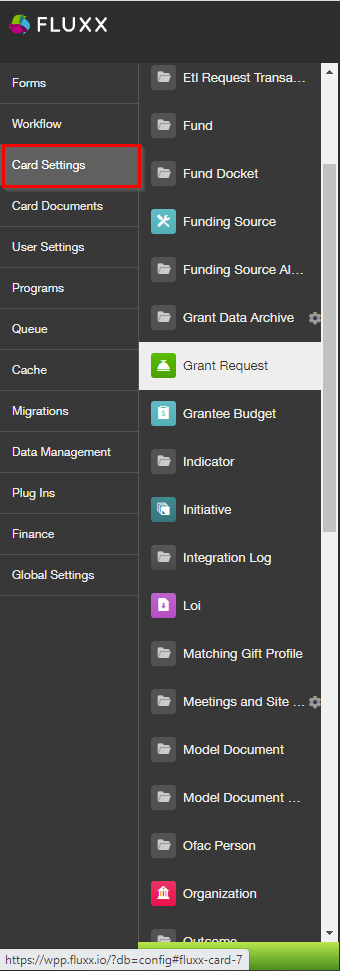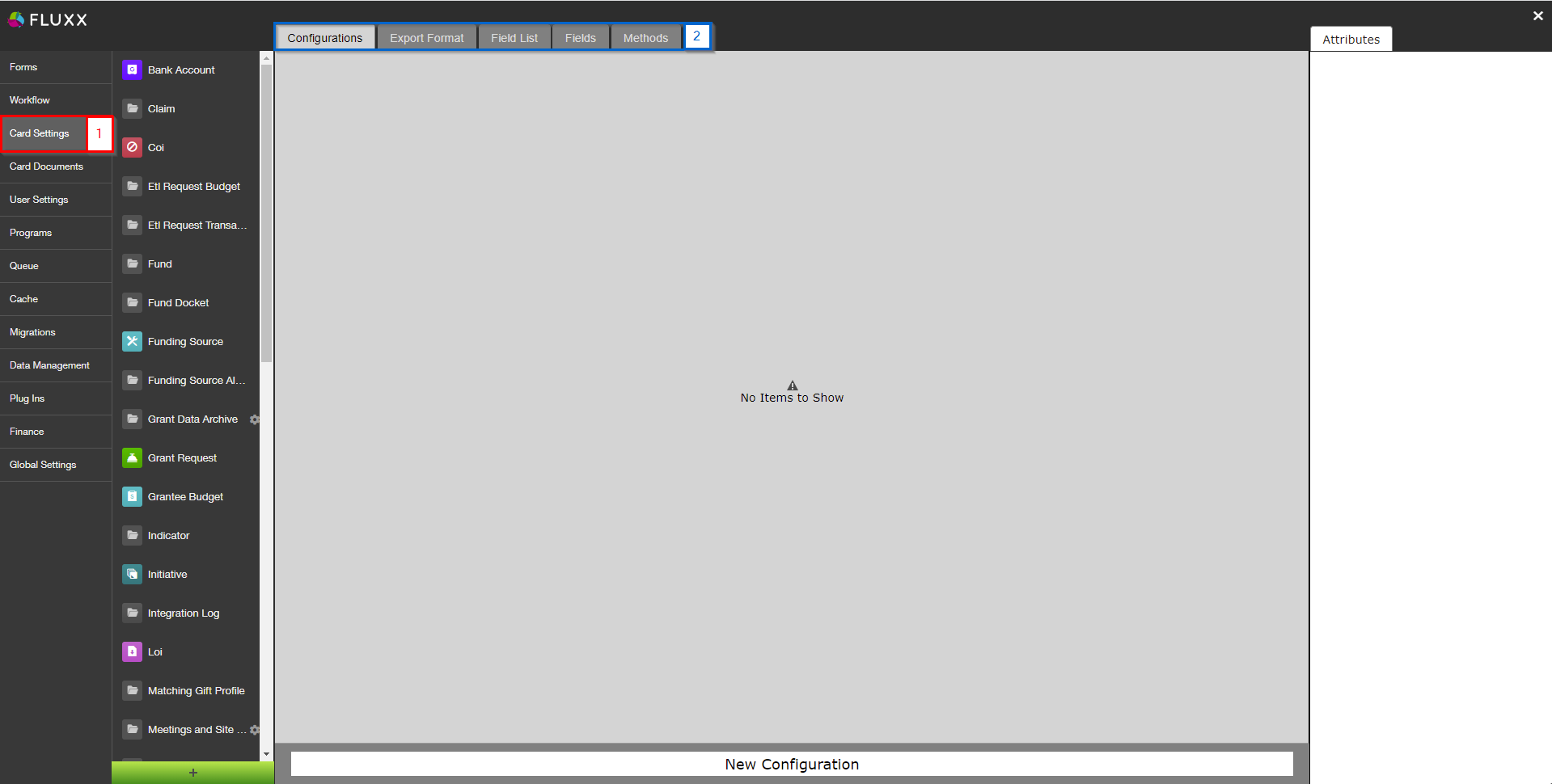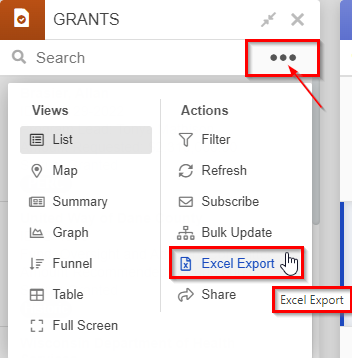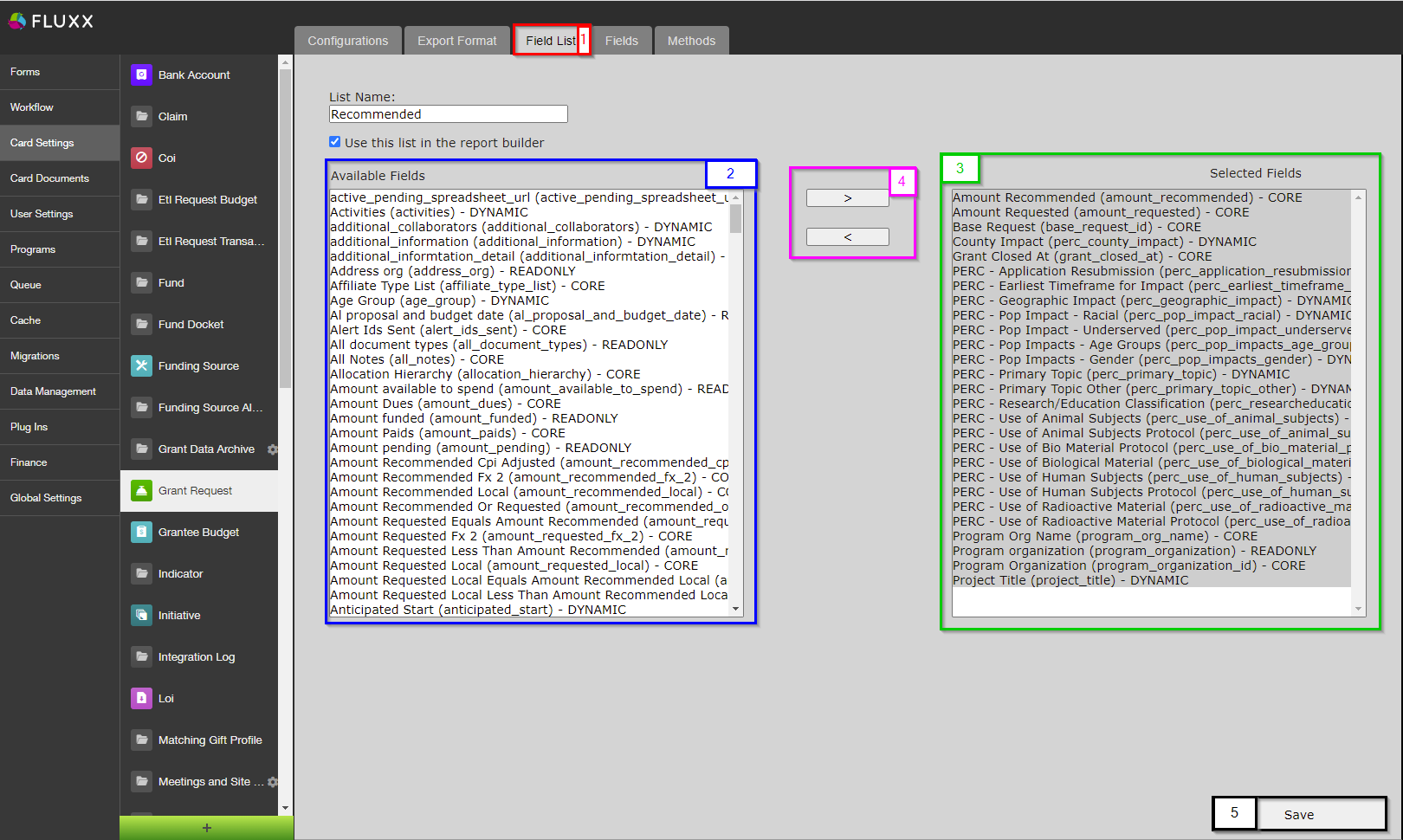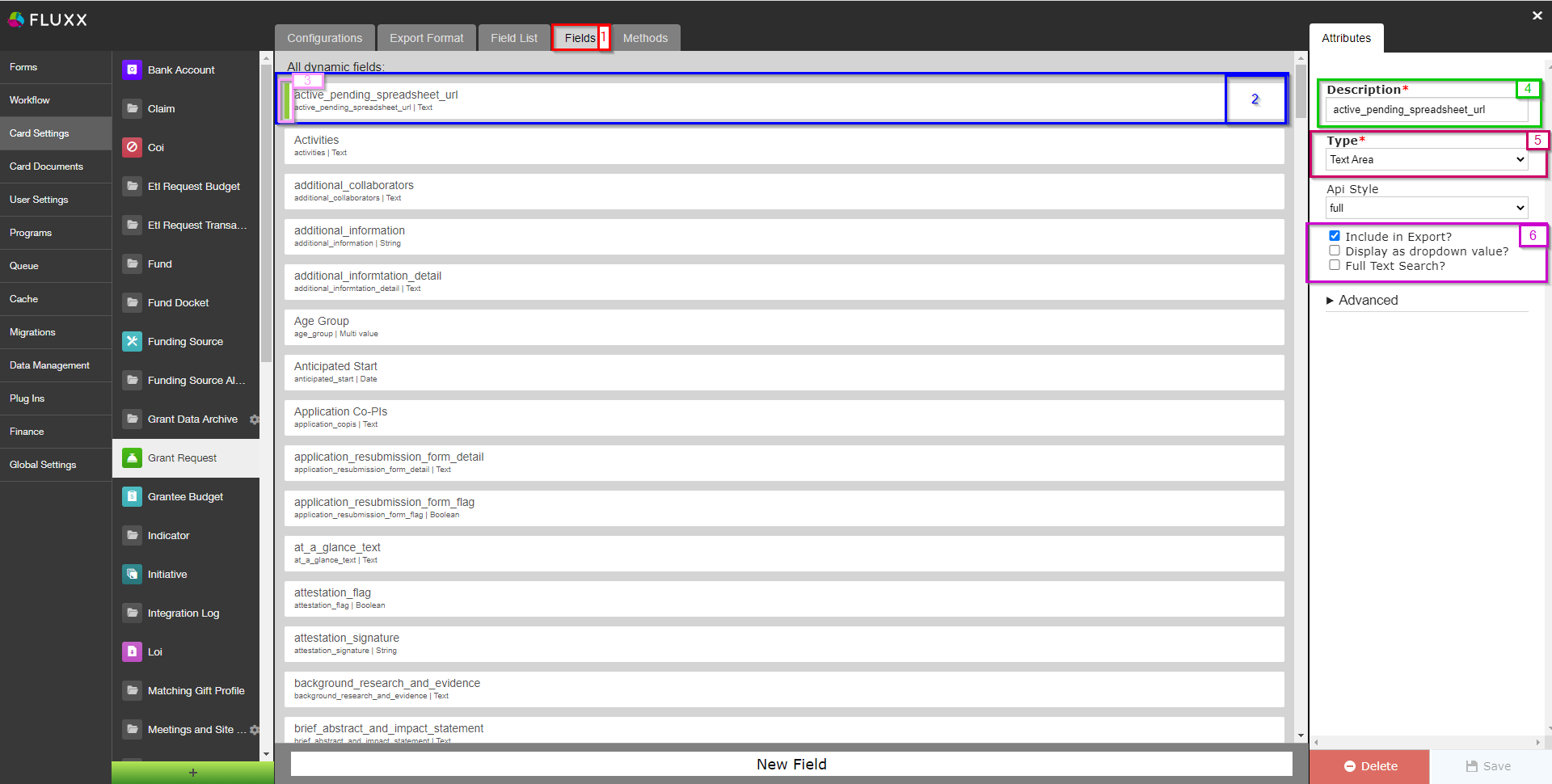Card Settings Menu
In Fluxx, the Card Settings menu of the Admin panel contains a number of configuration settings that can control the Cards in the system for that given record type, the export format of a given record type, the list of fields listed as 'Recommended' from the Ad-Hoc Reports builder, the format/configuration of Fields found within that record type, and any code "Methods" used for that record type (see this Fluxx article for more information on Methods).
The Card Settings Submenu from the Admin Panel screen, with the "Grant Request" record type selected within the Card Settings Menu.
Within the Card Settings Menu for each Record Type, you can find five separate tabs that allow you to edit/configure various different aspects/settings within that record type. See the screenshot below for the highlighted items and beneath it for explanations of said items.
- Box # 1: Shows the Card Settings Menu selected from the main Admin Panel menu.
- Box # 2: Shows the five tabs where different settings can be found for a given Record Type (independent of which Record Type you have selected). See the sections below for explanations of each of those tabs (in order).
Configurations
Before You Begin...
Fluxx has a great article discussing Card Configurations which will help you to better understand everything discussed, below. The article also walks through creating a new Card Configuration and the implications of doing so.
See Fluxx's article, here: https://fluxxdev.atlassian.net/servicedesk/customer/portal/1/article/3177349182?src=492022410
Configurations in the Admin Panel
As stated in the Cards section of the Fluxx Grantmaking – General Overview page, a Card is the visual display of a single record type or of a subset of records within a single record type. The Card Configurations menu allows you to change/edit/create new cards within a given Record Type to be used and seen in the system.
For example, within the Grant Requests record type, the WPP has two Card Configurations set up: "Denied and Withdrawn" and "Grants." These cards represent subsets of the overall card, "Requests and Grants," which stores all grant applications (even those that are not accepted or withdrawn by the applicant) and awarded grants. The Card "Denied and Withdrawn," as the name implies, contains the subset of Grant Applications that were explicitly declined by the WPP and those applications that were intentionally withdrawn from consideration by their applicant. The Card "Grants" also stores a subset of Requests and Grants, but in this case stores all applications that ever became fully awarded Grants.
Export Format
The next tab over is the Export Format tab, which is used in determining what fields get exported (and in what order) when the Card Action "Excel Export" is used from the card "Actions" menu (see also the screenshot below).
Screenshot showing how one uses the "Excel Export" option from a card. First, click the "Three Dots" menu found in the top right-hand corner of the card, then under Actions select "Excel Export."
The Export Format page can be used to configure the format that the data gets exported to Excel with. Please see the screenshot below to see important items highlighted on the Export Format page and beneath the screenshot for explanations of these highlighted items.
- Box # 1: Shows the "Export Format" tab when it is selected.
- Box # 2: Shows the configurable label for each of the columns that will display in the Export. You can change any of these labels so that they are more understandable for staff. Please note, however, that changing a label here will change the label for that column on all future Excel exports from this Record Type unless this label is subsequently changed again.
- Box # 3: Shows the Internal Field Name of the column in question. This can be useful (especially after a column label has been changed) for seeing what the field actually is. Can be matched with the Internal Field Name from the Fields tab to confirm the exactly field that you are looking at.
- Box # 4: Shows an arrow that is both an up and down arrow (↑ and ↓). By clicking and dragging on this arrow, you can move columns up or down in the Export format to change/determine the order that the columns should be exported in.
- Note: The order in which the columns appear is as follows: The top column will be displayed farthest to the right in the Export table, and the bottom column will be farthest to the left in the Export table. You can, therefore, move columns up/down on this page to effectively move columns to the right/left (respectively) in the eventual exported table.
- Box # 5: Shows the Save button. If you've changed a label or moved a column around in the export format, you must hit the save button in order for your changes to be effectuated. Otherwise, your changes will be discarded.
Field List
The next tab over is called "Field List." From this screen, you can tell the system which columns per record type should be considered "Recommended" for the purposes of Ad-Hoc reports. See the screenshot below to see highlighted important items from this screen taken from the Grant Requests record type's Field List and beneath the screenshot for descriptions of said items.
- Box # 1: Shows the Field List tab selected.
- Box # 2: Shows the list of all available fields for this specific Record Type.
- Box # 3: Shows the list of fields that have been selected to be considered "Recommended."
- Box # 4: Shows the arrows that allow you to move a field between the list of all available fields (again, on the left) and the list of selected "Recommended" fields (on the right). Click on a field from either list to highlight it and use the ">" arrow to move a field from the "Available Fields" to the "Selected Fields" (Recommended Fields) list and the "<" arrow to move a "Selected" (recommended) field back to the list of Available Fields (making the field no longer a "Recommended" one).
- Box # 5: Shows where you can Save your selections. You'll want to make sure to hit Save if you've made any changes whatsoever; if you fail to do so and click over to another tab, all unsaved changes will be discarded.
As stated previously, these "Recommended" columns can then be seen when editing Ad-Hoc reports. As you can see, the columns listed under the "Recommended" list match those from the previous screenshot taken from within the Field List screen.
Fields
Before you go on...
This tab of the Card Settings menu is also discussed in the article Fields, Field Types, and Field Modification in the section Field Modification.
As in that section, provided here is a link to a useful Fluxx article that discusses many of the same things discussed here: https://fluxxdev.atlassian.net/servicedesk/customer/portal/1/article/1451884575?src=83393115
The Fields Tab
The Fields tab is used to view custom fields within a specific record type and potentially edit those fields (though you should be highly cautious when doing so – see the "Editing Existing Fields" section here for warnings – also below).
- Box # 1: Shows the selected Fields tab.
- Box # 2: Shows the Field that you currently have selected. You can tell which Field is currently selected NOT ONLY based off of the name (match name of Field with "Description" from box # 2), BUT ALSO from the slim green line that appears to the LEFT of the Field name.
- Box # 3: Shows the slim green line mentioned above which helps to show you which field is currently selected.
- Box # 4: Shows the Field Description, which acts as the External Field Name as well as the default label for the field whenever it is added to any Themes (forms) of the Record Type selected (in the image above, Grant Requests). This Description field can be updated without breaking anything in the system (the same is NOT true for other items on this screen),
- Box # 5: Shows the Field Type for the Field selected. You can change the Field Type after a field has been created. However, THIS IS INCREDIBLY DANGEROUS AND SHOULD BE DONE ONLY AFTER YOU HAVE TESTED DOING SO IN PRE-RPODUCTION AND CONFIRMED THERE ARE NO NEGATIVE REPURCUSSIONS. In general, updating a Field Type should only be done if the field itself has no data and was created incorrectly. In most cases, it is best to simply create a brand new field. Do NOT change Field Types on fields with migrated or existing data (unless you are OK with losing that data). The data stored is specific to the field type. If you change the type on an existing field with data, for example, a date value will not convert to text or text value to a numerical value. Changing the field type will change the way the data is stored in the database. After a field type change on a field that had existing data, that data will no longer be visible on the front end. The data will have to be re-entered/imported into the new field type in the correct format. If you ARE changing a field type, remember to:
Check existing visibility conditions built with this field.
E.g. When you change the select field to a Boolean field, but you are referencing the select value in your show condition, it will cause the section of the form to not open
Update the form by deleting the field originally on the form, and adding the field with the new field type (otherwise, the item will NOT be updated correctly on your Theme).
- Box # 6: Displays other options you can change/configure for this field. Descriptions of what the various options mean/do:
- Include in Export: Includes the field in the Excel Export function.
- Display as dropdown value?: Only for select, Boolean, and model fields. Will display the entries of the field as a dropdown when being used as a linking field for an embedded card.
- Full-Text Search?: Includes the field’s data as part of what is searched in a card search (i.e. when typing in a search term in the "Search" bar of a card with the same Field Type as this field).
Methods
Methods are pieces of code used to perform automated tasks in the system in a way that is not provided out-of-the-box. WPP does not currently use any methods, therefore this tab is not used for any record type at this time.
